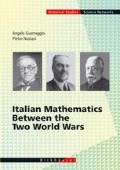Access this chapter
Tax calculation will be finalised at checkout
Purchases are for personal use only
Preview
Unable to display preview. Download preview PDF.
Reference
Cf. G. Gentile, La riforma della scuola in Italia, Le Lettere, Firenze, 1989, pp. 94–95.
The letter is quoted in A. Guerraggio, P. Nastasi, Gentile e i matematici italiani. Lettere 1907-1943, Boringhieri, Torino, 1993, p. 185.
Cf. Periodico di Matematiche, S. IV, vol. III, No. 4 (1923), p. 339–341.
The letter is quoted in R. Simili, La presidenza Volterra, in R. Simili, G. Paoloni (eds.), Per una storia del Consiglio Nazionale delle Ricerche, Laterza, Roma-Bari, 2001, 2 vol. I, p. 91.
Cf. G. Gentile, La riforma della scuola in Italia, quoted, p. 140.
G. Levi Della Vida, Fantasmi ritrovati, Neri Pozza, Venezia, 1966. Giorgio Levi Della Vida (1886–1967), important Orientalist, would be one of the few university professors who — with Volterra — would have the courage to refuse in 1931 the oath of allegiance to fascism.
In G. Turi, Giovanni Gentile. Una biografia, Giunti, Firenze, 1995, p. 336.
In E. R. Papa, Storia di due manifesti. Il fascismo e la cultura italiana, Feltrinelli, Milano, 1958, p. 92.
The letters are published in A. Guerraggio, P. Nastasi, Gentile e i matematici italiani, quoted, p. 142–167.
The letter, in possession of the family of Adriana Enriques, has been published by O. Pompeo Faracovi, Federigo Enriques: filosofia e storia del pensiero scientifico, Belforte, Livorno, 1998, p. 279.
Cf. A. Guerraggio, P. Nastasi, Gentile e i matematici italiani, quoted, letter to Gentile from the 15th April 1923, pp. 150–51.
The letter is published in G. Paoloni, Vito Volterra e il suo tempo (1860–1940), Accademia Nazionale dei Lincei, Roma, 1990, p. 141.
Cf. A. Guerragio, P. Nastasi, Gentile e i matematici italiani, quoted, p. 95. The interlocutor is Vittorio Emanuele Orlando (1860–1952), another exponent of the liberal opposition, who hesitated to collaborate and whom Gentile invited to learn to “distinguish” so as to “overcome” his political reservations.
As G. Turi, Giovanni Gentile. Una biografia, quoted. pp. 422–23, documents, the fascist government interfered several times in order to save the project of the Encyclopaedia from the economic crash.
Cf. G. Gentile, L’Enciclopedia Italiana e il fascismo, letter to the chief editor of La Tribuna, 28th April 1926.
Rights and permissions
Copyright information
© 2006 Birkhäuser Verlag
About this chapter
Cite this chapter
(2006). Fascism: somebody rise, others fall. In: Italian Mathematics Between the Two World Wars. Science Networks. Historical Studies, vol 29. Birkhäuser Basel. https://doi.org/10.1007/3-7643-7512-4_4
Download citation
DOI: https://doi.org/10.1007/3-7643-7512-4_4
Publisher Name: Birkhäuser Basel
Print ISBN: 978-3-7643-6555-4
Online ISBN: 978-3-7643-7512-6
eBook Packages: Mathematics and StatisticsMathematics and Statistics (R0)

